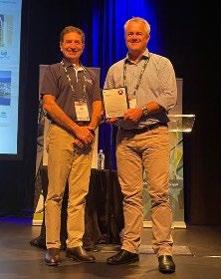STANDARDS
SUBSURFACE UTILITY ENGINEERING (SUE) ENHANCED THROUGH COLLABORATION Michigan on the afternoon of May 20, 1992, one man lay dead and seventeen were hospitalised from wounds received in the blast.
Rob Sansbury Principal, Infrastructure Manager at Stantec
The success of managing subsurface utilities in Australia (and in many places in the world) can be measured by stakeholder collaboration. These stakeholders include a long list of project owners, developers, project managers, State and local authorities, public utility authorities, design engineers, surveyors, locaters and last (but by no means least) the constructor on the ground. This article contends that the correct practice of SUE is very much dependent on successful collaboration among stakeholders. To reflect on a regrettable incident in the US several years ago: The tell-tale hiss and the distinctive smell of natural gas got most of the workers out of the area in time, but not all of them. When the dust had cleared from the explosion that rocked the USA town of Rochester in
78
It was clear what had happened: a construction crew had disturbed an underground gas line while working on a beautification project downtown. Technically, the required precautions had all been followed, the one-call (equivalent of Australian Dial Before You Dig) centre had been alerted as required by law, the gas company had made its mark on the ground showing where it thought the gas line was supposed to be. The engineer had called for excavation at the particular spot (of course with a disclaimer regarding the accuracy of underground utility data) and the construction people had “hand-exposed” as required, at the spot indicated by the engineer. But all this was small, if little consolation to the families of the dead and injured. And what’s more, no one could be held accountable for the Brobdingnagian tragedy. (Onecall - the USA equivalent of DBYD). The result of this tragedy, and many similar incidents across the USA, led the Department of Transport to develop a rulebook called ASCE38-02 that mandated the responsibility for the management of underground utilities to the subsurface utility
engineer (that is part of the engineering design team). Do we have an equivalent rulebook in Australia? Australia developed a similar type standard (AS5488) in 2013 however, it only related to Subsurface Utility Information (SUI). In 2019, an upgrade version of AS5488 was released - AS54882019 (Part 2) to include a section covering SUE. The 2019 update to AS5488 was produced under Standards Australia’s guidance, with Bruce Wilson (former Director-General of Queensland Transport) acting as Chairman. As the National Engineers Australia representative on the committee, I led the development of AS5488-2019 alongside Mark Follett, Utilities Design Engineering Construction, who provided critical advice and input. AS5488-2019 is one of six Standards (or rulebooks) across the globe. The others were designed in the USA, UK, Canada, Malaysia and Ecuador. Subsurface Utility Engineering (SUE, as defined in AS54882019) refers to an engineering management process that involves engineering, geophysics and geospatial disciplines and technologies. Specific risks associated with utility mapping are managed at appropriate quality levels, including utility coordination, utility relocation design and coordination, utility condition assessment, communication of Subsurface Utility Information (SUI) utility
ENGINEERING FOR PUBLIC WORKS | MARCH 2021



























